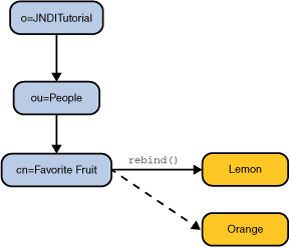Lesson: Naming and Directory Operations
Java 教程是为 JDK 8 编写的。本页中描述的示例和实践未利用在后续版本中引入的改进。
添加,替换或移除绑定
The Context interface contains methods for adding, replacing, and removing a binding in a context.
Adding a Binding
Context.bind()is used to add a binding to a context. It accepts as arguments the name of the object and the object to be bound.
Before you go on:The examples in this lesson require that you make additions to the schema. You must either turn off schema-checking in the LDAP server or add the schema that accompanies this tutorial to the server. Both of these tasks are typically performed by the directory server's administrator. See the LDAP Setuplesson.
// Create the object to be bound
Fruit fruit = new Fruit("orange");
// Perform the bind
ctx.bind("cn=Favorite Fruit", fruit);
This examplecreates an object of class Fruit and binds it to the name "cn=Favorite Fruit" in the context ctx. If you subsequently looked up the name "cn=Favorite Fruit" in ctx, then you would get the fruit object. Note that to compile the Fruit class, you need the FruitFactory class.
If you were to run this example twice, then the second attempt would fail with a NameAlreadyBoundException. This is because the name "cn=Favorite Fruit" is already bound. For the second attempt to succeed, you would have to use rebind().
Adding or Replacing a Binding
rebind() is used to add or replace a binding. It accepts the same arguments as bind(), but the semantics are such that if the name is already bound, then it will be unbound and the newly given object will be bound.
// Create the object to be bound
Fruit fruit = new Fruit("lemon");
// Perform the bind
ctx.rebind("cn=Favorite Fruit", fruit);
When you run
this example, it will replace the binding created by the
bind() example.

Removing a Binding
To remove a binding, you use unbind().
// Remove the binding
ctx.unbind("cn=Favorite Fruit");
This example, when run, removes the binding that was created by the
bind() or
rebind() example.